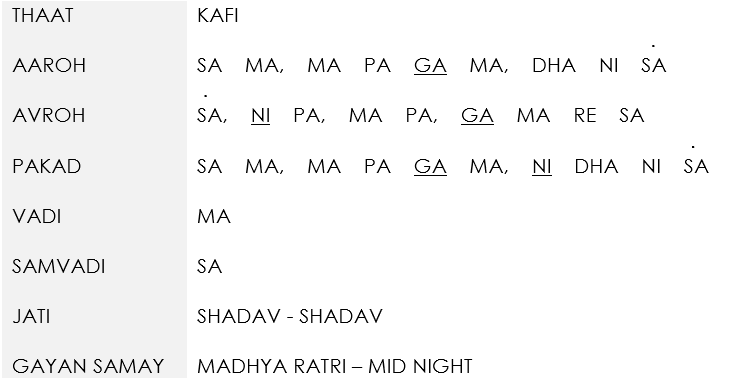Raag Bahar
Raag Bahar belongs to Kafi thaat of North Indian Music System. It is the Raag from the medieval period and suppose to be created by Sufi Music Scholar Hazrat Ameer Khusro. The nature of the Raag is filled with Shringar Ras and Bhakti Ras. In this raag Madhyam is the prominent note so we should use Nyas on this note especially.
This raag has some versions as a combination also -Basant-Bahar, Bhairav-Bahar, Malkauns-Bahar, Adana-Bahar, Bageshree-Bahar, etc.

Characteristics or Visheshta of This Bahar Raag:
- As there are no signs of this raag in any ancient script. It directly shows that this is a Modern Raag from the Medieval period.
- This raag seems to be a mixture of three different Raags - Adana, Bageshwari, & Miyan Malhar.
- The time zone to sing this raag is midnight but in Basant Ritu. We are allowed to sing it any time.
- In ascending order or aaroh PA (Pancham) note is used Vakr, and in descending order or avroh GA (Gandhar) note is used Vakr. You can refer to its Aaroh and Avroh sections mentioned above.
- It is a Chanchal Prakriti (Playful Nature) Raag. Hence, often used in Bada Khayal or Maseetkhani gat.
- Malhar is the Sam Prakriti Raag.
Comparison of Raag Bahar with Raag Miyan Ki Malhar (Click Here for Raag Miyan Ki Malhar)
Similarities
- Both Ragas are Modern time Ragas as there are no such descriptions found in ancient scripts or records.
- Both belong to Kafi Thaat.
- Use of Komal Ga (Gandhar), Shudh Ni (Nishad) & Komal Ni (Nishad) in both Ragas.
- Dha (Dhaivat) is Varjit Swara in Avroh in these Ragas.
- Avroh belongs to Shadav jati in both Ragas.
- Both of the Ragas are Seasonal. Bahar Raag belongs to Spring Season & Raag Miyan Ki Malhar belongs to Rainy Season.
- Time to sing this raag is also same for both: Mid-Night (12-3 AM)
- Use of Ga (Gandhar) is Vakr in Avroh or Descending order in these Raags.
- Use of Ma (Madhyam) as vadi & Sa (Shadaj) as Samvadi is also a common factor.
- Both of the Ragas use the following note-groups:
- GA MA RE SA
- NI DHA NI SA
- NI PA
Differences
- The nature of Bahar Raag is playful or Chanchal pravarti, whereas Miyan Ki Malhar has a serious tone.
- Bahar Raag is performed in Madhya Saptak (Middle Octave) or Taar Saptak (Upper Octave), whereas Miyan ki Malhar is performed in all Saptaks (Octaves).
- Aaroh (Ascending order) of Bahar Raag belongs to Shadav jati, whereas Miyan Ki Malhar belongs to Sampoorna jati.
- The use of Komal Ga (Gandhar) in Bahar Raag is like it has a resonating touch of Ma (Madhyam) but in Miyan Ki Malhar it is used as Komal Ga (Gandhar).
- Use of “NI DHA NI SA” note group. In Bahar Raag it is used with equal Gaps whereas in Miyan Ki Malhar we should hold NI (Nishad) for a longer period, Like: “NI S DHA NI S S SA”.
- In Bahar Raag use of SA MA shows the identification mark of the Raag, and in Miyan Ki Malhar RE PA shows the identification mark for the raag. With their use, we can differentiate these.
- Usually, Vadi-Samvadi Swaras are the same for both Raags but still some scholars mention SA-PA as Vadi-Samvadi of Miyan Ki Malhar.
MCQ
1. This Raag belongs to which thaat?
a) Kafi
b) Kalyan
c) Pooriya
d) Bhairav
2. Select Jati of this Raag?
a) Audav - Shadav,
b) Shadav - Shadav,
c) Shadav - Audav,
d) Shadav - Sampoorna
3. Select the correct combination of Vadi-Samvadi?
a) RE-MA
b) MA-DHA
c) MA-PA
d) MA-SA
4. What is the suitable time for this raag?
a) Early Morning,
b) Afternoon,
c) Evening,
d) Mid-Night
5. It is allowed to use only one Ni (Nishad) in this raag either Shudh Ni or Komal Ni?
a) True,
b) False
Answers: 1(a), 2(b), 3(d), 4(d), 5(False).